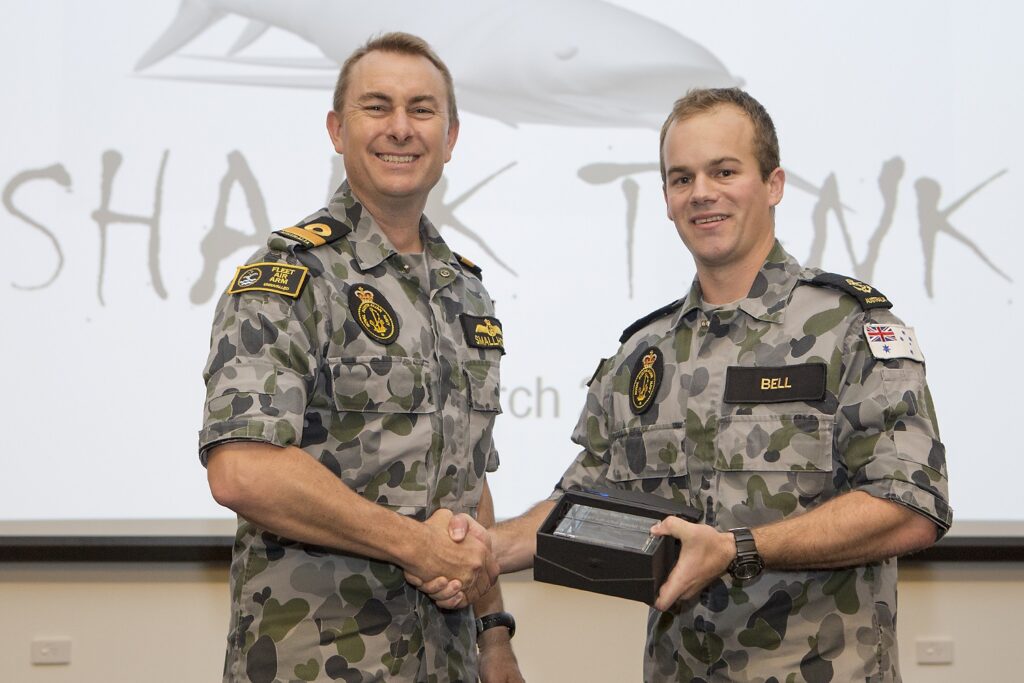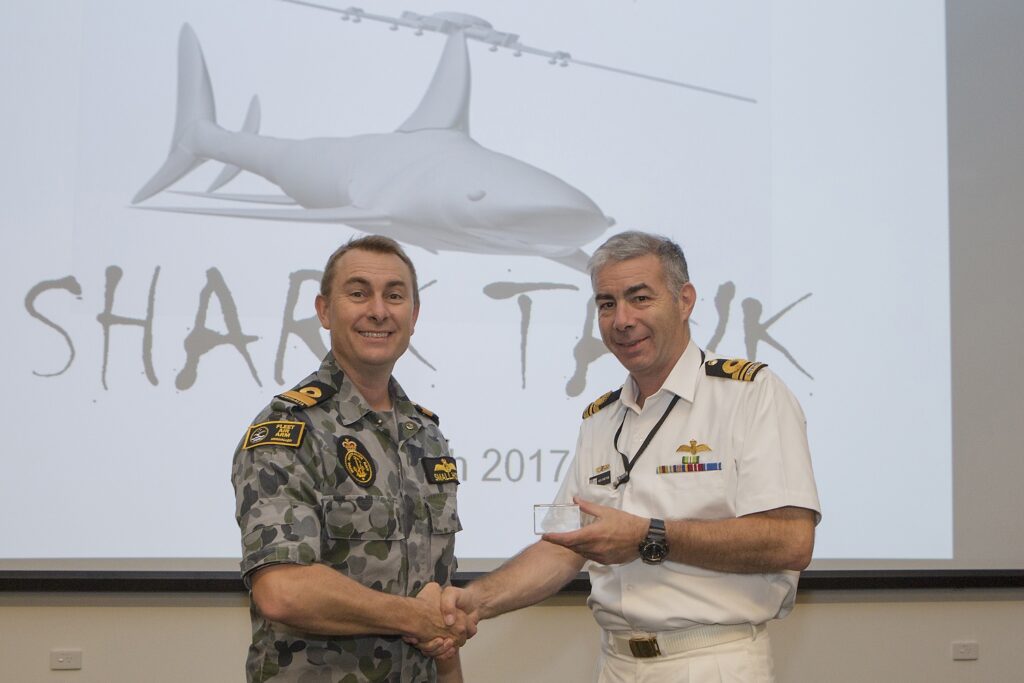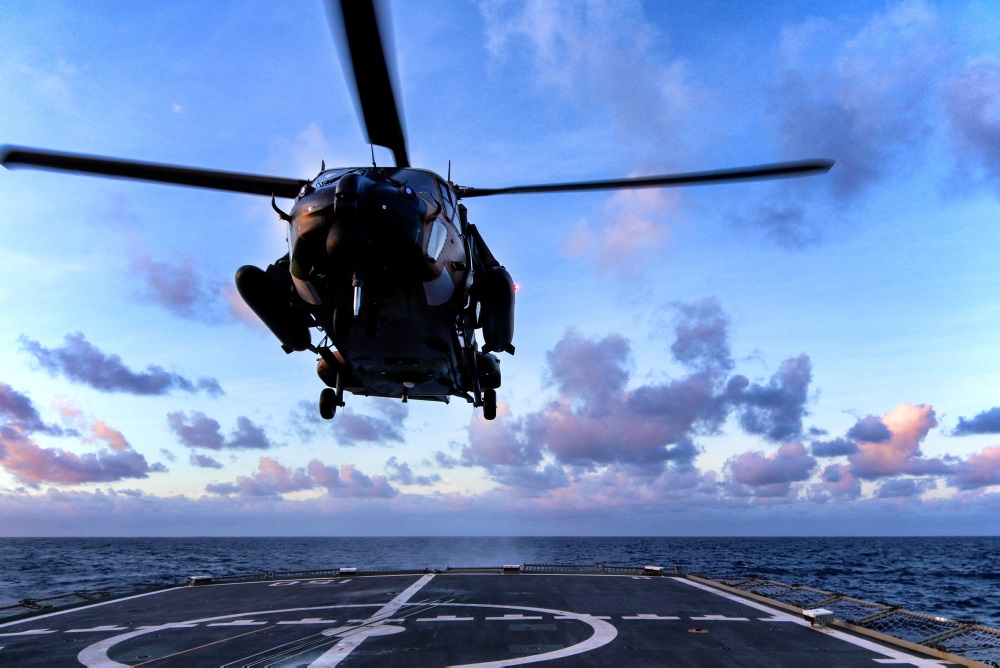Bringing innovation to a place where rules, hierarchy and tradition are deeply ingrained in the very fabric of the institution can be difficult. How does an organisation overcome this obstacle? We talk to Commodore Chris Smallhorn, about how the Navy is creating a culture of innovative behaviour.
The Royal Australian Navy and our country is entering into a period of unprecedented Naval ship building over the coming decades. However part of the Navy has been in a focused re-capitalisation for some years. By December this year the RAN’s Fleet Air Arm will have replaced all of its aircraft across four Squadrons. Such change requires innovative behaviours to ensure the capital investment meets our nation’s military needs to the best and fullest extent possible. The Chief of Navy, Vice Admiral Time Barrett, has set his Navy on a course of building innovation at the core of business.
Commodore Chris Smallhorn is the Commander of the Fleet Air Arm of the Royal Australian Navy and has taken this strategic direction and is at the forefront of creating a culture of innovative behaviour. CDRE Smallhorn’s innovative behaviours directive seeks to implement the Chief of Navy’s vision in Naval Aviation and the ideas employed may well be suitable for your business or complex endeavour.
Show notes and links for this episode
Commodore Chris Smallhorn’s profile
You can subscribe to this podcast on iTunes, Spotify, Soundcloud, Stitcher, Libsyn, YouTube or wherever you get your podcasts. You can follow us online on Flipboard, Twitter, or on sbi.sydney.edu.au.




Sandra Peter Introduction: Bringing innovation to a place where rules, hierarchy and tradition are deeply ingrained in the very fabric of the institution can be difficult. We talk to Commodore Chris Smallhorn to find out how the Royal Australian Navy does it.
Introduction: From the University of Sydney Business School this is Sydney Business Insights. The podcast that explores the future of business.
Sandra: Hi I'm Sandra Peter and I recently spoke to Commodore Chris Smallhorn at the Naval Air Station in Nowra at the First Fleet Air Arm Shark Tank. This was part of a Navy-wide program encouraging innovative behaviour and ideas and input from staff at all levels in the organisation. Commodore Chris Smallhorn is the commander of the Royal Australian Navy's Fleet Air Arm and he is at the forefront of creating the culture of innovative behaviour. Thanks for talking to us today.
Chris: Thanks.
Sandra: How does the Navy or the Fleet Air Arm think about innovation?
Chris: We don't so much think about innovation as much as we think about innovative behaviour. If you think of the word innovation it can be both a noun and verb but it's actually the behaviour that I'm after. It's the adjective piece of innovation that I think is important. I'm trying to work as a leadership team to create an environment in which every individual in the organisation is inspired to have a behaviour that is one that looks for problems and when they see them they don't walk past them. They look at that problem, they go what could I do with that to make it better and then give them an opportunity, a structure, an opportunity in a system in which they can bring that idea forward and think about the idea give them the tools to be able to think about the idea and in a bit of a systems style of fashion.
Break it down into its problems sets look for the solutions and bring that forward as a rough package enough to start the conversation to have the discussion. So that's a behaviour. Somebody that doesn't walk past a problem somebody that looks for opportunity to continuously improve. So I guess as the Fleet Air Arm I would offer to you we don't so much think about innovation as much as we think about a particular innovative behaviour. And each time we get better we become a better organisation and become a high performing organisation. Our objective here is all around the provision of maritime warfare from the air in this case being an aviation outfit that fits into a wider joint effect from our Navy and from our defence force while in our business we sort of have to win.
And so what I'm looking to do here is create that environment in which everyone has a behaviour where they just don't accept second best. They're always looking for that next edge.
Sandra: The Fleet Air Arm is a business. How do you think about it as a business?
Chris: It's a great question because it is a business and whilst monetarily it is not as large a business as perhaps one of a major airlines. But it's more complex than a major airline. When you start looking at the types we operate the environments we operate within the threats that we need to deal with. So it's actually quite a complex endeavour but we also think about it as a capability that fits into a bigger picture. And this comes I guess that thought of team. And so there is the business element and it is a business but when I introduce the word business I think of business as an enabler as opposed to being the thing that the business. Business behaviours, business thinking are enablers that ensure that as a capability we deliver and to keep that business theme or verbiage going we deliver a product and that product is an absolutely assured capability on the water whenever our government calls for it and wherever they call for it. So we need to be able to rapidly move any given time with a ready to go capability and the business behaviour is one of the things that enables that capability to be delivered.
Sandra: So how do you build a culture of innovative behaviour?
Chris: It starts with an intent a leadership intent and a command intent as we like to use in the military. And so this is one of our command intents we have three command intents here in the fleet. Our first one is integrated warfare and that comes to the heart of what we exist for. The second two are designed to deliver against the first and the second one is innovative behaviour. And so I'll talk a bit about the program and how we're trying to bring innovation as a behaviour into the force. And I wouldn't want to suggest it doesn't already have a very strong culture of continuous improvement. This is about making good people better. And then the final command intent is civic virtue. It's an interesting command intent to hear in a military organisation, some of your listeners might think, but the reason that we have done it is about the provision and capability of warfare as a capability delivered but done with deep values because if you look at what these often very young people around this organisation may be asked to do they can be tough missions whether they're out doing a search and rescue mission a couple hundred miles off the coast or whether it's something more in that direct warfare as we know it. Or when they do it they must do it with deep values and an absolute sense that they're part of a community the Australian community in this sense and the Shoalhaven community as we're sitting here locally in that region as well is a strong part of who we are.
So a civic virtue is about delivering integrated warfare with deeply entrenched and practised behaviours as a community member.
Over the program that we've put together I guess I'd best described it in about three levels. Level one is we're working with the University of Sydney to develop a pretty unique course a masters level subject at this point in time that seeks to bring together disciplines that you would find resident in the Faculty of Engineering Systems Engineering in particular, Executive Leadership, Business and also psychology. So we're bringing together a whole series of disciplines into one compact course that the university and the Navy and Fleet Air Arm have called Systems Innovation. And that course will be targeted at junior level of our workforce not our brand new part but around about in rank terms the Leading Seaman Petty Officer level and in Officer terms or Lieutenant / Lieutenant Commander level. These are the future leaders of the organisation. So the people we're picking apply but they are also selected through their potential to rise later on. So these are high end people in an already high end group that are generally being looked at for something like this. We're about to run the first course. So that level one is a higher level of education where we're creating some tools based around the latest thinking in this business of systems based innovation. Whereas you say it's a behavioural innovation that is enabled through systems of behaviour is what we're trying to achieve out of that. That's not going to change the way any of our aviators fly a plane, fire or weapon, or any of our maintainers and engineers design and maintain a machine. But it will change the way they approach any problem in the future. They'll think about things differently after that. And that's what we need to do if we're going to bring these capabilities to the fore in the most effective fashion, we just need to keep looking at a different way of thinking that finds the edge that we need to win on the day of the race.
The next level down we've unashamedly stolen a pretty popular show's concept "Shark Tank". It just happens to work for us - the Fleet Air Arm shark tank turns into the acronym FAAST because it's about finding solutions and ideas from every level of our workforce and give them an opportunity to rapidly move those ideas into the hierarchy of the organisation where we have the tools and levers to pull to make good ideas that are demonstrable in their effectiveness to bring a better warfare effect at the end of the day that we've got those levers and dollars to actually make those ideas into reality. So that's a system though. We're given the opportunity for every level of the organisation to feed an idea in so we're creating a structure again a system that enables good ideas to come through.
And then the final level I guess at this stage is the just do it's. Inspiring the workforce at every level of the organisation that it is okay to see that idea bring it to your supervisor in a rapid system that enables that idea without going through a shark tank concept for something more complex. But to get that idea into the headquarters environment where we can if necessary and we believe it's going to work for us that we could fund it and make it happen and most things can happen quite quickly. So that's our innovation behaviour program. It's leadership command led it's articulated in a command directive which is a document if you like like a CEO might put out to the workforce to say this is what we're going to do. And it's enabled through essentially three loose layers of system from a high end training giving those tools right at the master's level all the way to that's just a good idea, let's get on and do it, and it's OK to do that.
Sandra: How do you encourage that small good idea to come to the fore, how do you empower people, how do you encourage creative dissent in an organisation that in its nature is not geared towards...
Chris: Aviation and military aviation. No matter which way you cut it is a risky endeavour made safe through good risk management, excellent training and just outstanding people and equipment. And I think we have all of those things and that's what enables us to do what we do in a safe fashion and an effective fashion that makes sure that we're reliably we're going to be where the government want us on any given day. So a system like this means it has to be regulated to make sure that that all works. Regulated environments almost by their definition are likely to suppress artistic or abstract thought. The challenge on our table as a leadership team is how do you inspire everybody who works in a regulated environment to actually be allowed to think outside the box to feel they've got the authority to do so. Well I would offer to you that what we're trying to achieve is we want that person not only to be able to think outside the box while operating regulated environment but know when to do it know when it's safe to do so when the right time is to do it. How long to dwell in that area of artistic and abstract thought and then provide the systems and the ideas on how to bring that artistic abstract different thought of doing business back into the regulated environment so we can then gain the benefits of it in this largely risky endeavour made safe through good systems.
It needs to be leadership led and indeed just the very existence of an innovative behaviour program starts to inspire the opportunity to get everybody to talk.
Today you attended the first Fleet Air Arm Shark Tank the first FAAST event and saw two really magnificent ideas come out of our work force one from our middle management and one from one of our most junior members of the organisation. What I'd take out of that event amongst a good idea that is going to save taxpayers dollars is a really junior member of the organisation was happy to sit up in front of some of the more senior members of the organisation and a crowd of in this case his peers and a panel made up of a variety of ranks some of which were his rank and some which were a little bit higher. He stood up there and brought in an idea that we said well why wouldn't we do this. So just by that individual doing it you've probably just inspired another 10. Or 20. That master's level program will inspire leaders in an innovative behaviour sense, people that you can go to and go "what could I do to take this idea forward". Each element of the organisation our squadrons and units have got innovation leaders innovation champions the point of those people is so that everybody has got somebody to go to.
So although somewhat clumsily explained how do we achieve it? Leadership led with a strong narrative by every part of the senior leadership organisation enabled through a command directed innovative behaviour program that had three layers to it. And the very existence of all of that and events like the FAAST that you saw today is to give that opportunity both to inspire people to do the same that it's okay to bring an idea forward but in a hierarchical organisation like the military, heavily regulated, to let them know they have got the licence to do that it's OK.
Sandra: A culture of innovative behaviour also carries with it the assumption that some of these projects will fail. How do you think about failure?
Chris: It's such an important part of building a culture where people feel the licence to give something a go. The first thing I guess I'd offer to is that in the game of innovative behaviour I tend to think that failure is success meaning it's a data point. You've given something a go and perhaps it didn't work. Well if it didn't work then that's a successful outcome. We now know that we either need to modify what we're trying to do or perhaps that's a line of work that no longer is going to deliver for us.
Better to find out then than at some other stage down track by just putting it in place without having a behaviour which has the organisation test things and ensure that they make sense and look at them through a value proposition. This is this innovative behaviour that takes it from an idea with a foundation of systems knowledge and cultural change understanding allows you to actually test these ideas through to a conclusion.
So hopefully I'm expressing the point of the importance that innovative behaviour is underpinned by a system's way of thinking but it's allowing you to operate artistically inside that system. But in our game as well, and our game being aviation, should we try and do something that is not sufficiently well thought through. There can be some fairly deleterious effects. So by way of example at the moment one of the innovations that one of the team came up with last year was to employ radio frequency identification in our tool control systems. Clearly knowing exactly where every tool is before an aeroplane goes flying is really important because what you don't want is one left inside the aircraft by mistake and then jamming up a flight control system or an engine control system and obviously causing an accident somewhere down the track. So we have very rigorous tool control systems. But like anything rigorous it has an opportunity cost to it. In this case it's clear that people monitoring where everything is and we use a tag system where each individual when they take out a tool they take a tag, just a little round disk, and they hang it where the tool was. Before tool control is signed off as complete, we make sure all the tags are back in the right place. That's how we know everything's closed. Of course radio frequency identification used extensively and logistics offers an opportunity to do something similar and there's a couple of aviation organisations that are using this. None that I'm aware of in Australia, I could be proven incorrect there from an aviation perspective but we felt this may offer an opportunity for us. While we're trialling that system, we're trialling it on a flight line and so on an aircraft that is being maintained and will go flying. I can't just rely on that system that is yet to be proven. So we need to manage it in parallel with the tool control system that is currently approved.
So here now you have this innovative idea which our innovative behaviours that we're trying to instil is turning into something real and for us to gain the benefits of it, the best way is for us to test it in the live environment. But to make sure we don't make any errors in aviation we keep the safe system of work that we fully understand in place so they're operating in parallel and evaluation and real time safe systems of work all happening at same time. Because in this case if we were to make a mistake from an aircraft perspective this is a no fail business for us. The effects clearly are not good and can result in peoples lives. So when we're playing around with whether we have safe flying or not, I'll never risk safety over the new idea but that won't let it stand in the way. It means that we will design systems of thinking and processes for everybody to be able to bring forward that idea and still be able to test out that idea in the environment and some of our ideas won't have any risk to safety. But some of them do. And we need to as an organisation to be really mature in the way we approach that.
Sandra: So the ideas can fail but yet the system doesn't fail as a whole.
Chris: Absolutely. We're setting up a fail safe mechanism is probably the way to think about as opposed to safe fail fail safe meaning of course it is stopped from failing and we put in known safe systems of work to make sure that we can trial a new idea but still ensure that it's a fail safe system as opposed to provide opportunity for a safe system of failure. That's not what we're looking at here. But the innovative idea that we're trying. That may well not work. So one of the examples of what we're doing right now like RFID is also looking at using Google Glass to see if we can do maintenance on a head up display. I don't know whether that will work or not work but we're going to give it a go. Only on work routines that will not be used to eventually go flying because we don't have an easy system to put in place to ensure that it's a fail safe system. So we trial it in an environment where we might trial doing pre-flight activity to ensure an aircraft is ready for flight. But we won't actually send it flying. We'll then roll that aircraft back in the line it will go through its normal safe system of work.
So there's two examples one where we're using a safe system of work right alongside an innovative idea and another one where we've completely separated them and said we'll only trial that in an entirely safe environment not for aircraft flight. Still testing two ideas - they might fail, they might pass and end up being a system that we're going to use in the fullness of time. But it's still fail safe from an operational perspective.
Sandra: So how do you communicate failure in an organisation?
Chris: We're fortunate I think in naval aviation and I think more broadly Australian Defence Force aviation that we almost already have a culture where we're willing to talk about where things have gone wrong. The reason for that is actually through our safety management system. Safety management systems on offer are very very powerful tools. It's not just about the safety. It's actually about the culture that comes with a safe organisation. In the very same way that safety is just an enabler to warfare. No use being able to be ready to go and do operations on behalf of the country if in fact your own safety culture is preventing you getting there in the first place. There are plenty of other reasons why you might not win on the day. Let's not let it be us and our own safety systems of work. So safety is an enabler to the warfare outcome in a military sense which is a slightly different way than we often think about it in an industrial sense. Looking through that lens of safety then, we've worked hard on this over the years and we continue to work hard at something that never stops, is making sure that people know if a mistake has been made or an error has been made that it's OK to talk about it, it's OK to tell the story. So whenever we have any sort of incident we raised an aircraft safety occurrence report. We raise quite a lot of these throughout the year. We then trend that information. We identify our weak points and we target them year by year, it's a very deliberate process. But also if we make an error and it's very strong in the air crew fraternity because time is allowed for it each day and we continue to try and build as a whole of workforce behaviour is if you make a significant error is you'll actually stand up on your feet in front of your peers and seniors and juniors and tell your story and say what you did.
To reflect on an error I made some years ago, a rather bad one, not more than about six miles from where we sit today I ran into a tree with a helicopter now by any account that's a bad thing to do. And in doing that we recovered the aircraft back to the base and we found out that I had indeed damaged the tip caps on the rotor blades. Clearly there's an obvious expense there. It's how the organisation responds to this. We're never measured by how we go and how we perform when things are going well but we're always measured by how we go when things are going wrong and the question is well as an organisation, an individual will we measure up. On this particular event instead of the organisation doing what it could rightly do, I've just damaged a very expensive piece of equipment, they could take some fairly punitive actions against the individual involved in this case, me. Typically that is not our mode of operanda at all. That's not what we do, it's quite the opposite. It is seeking a no blame culture unless blame absolutely should be levelled so no blame culture means that if you make the mistake tell your story write it up let others learn from it and know that nobody's going to make a victim of you out of this sort of thing. And that was exactly my experience and I would like to think remains the experience and the culture here today.
And on that occasion I had a bit more education to make sure I don't run into trees in the future. But I also stood up and I was a very junior pilot of the time in front of the entire squadron air crew which was quite a mass of people and some really experienced people. And I said what I did wrong. Now how the organisation responds after that can be one of two ways - yeah thanks noted or hard questions that was a dumb thing to do. Quite the opposite. It was as I left after giving that brief and a few general questions but really good rich questions, as I walked out the door the three most senior aircrew in the squadron including the Commanding Officer came and patted me on the back and shook my hand said thanks mate, that's what we do around here. Now, that's a culture and that's a culture where it's OK to tell your story when things go wrong. That's why I think we already have a strong footing to be able to tell the story when things go wrong because our safety culture demands it and we've worked really hard to keep that culture.
Sandra: Where do you look outside the organisation for these innovative ideas?
Chris: It's almost the heart of the question of where does innovative ideas come from. We've seen, not in every facet of our business, but we've seen a distinct change in where technology comes from and leads us to. What I mean by that is if I go back to the beginning of my career a great deal of new cutting edge technology actually came out of the military or the government framework. So if we think back to NASA for example. Whilst that was an integrated product team in many ways using some of today's terminology in that industry and government work together, it was absolutely a government driven government funded activity. What we're actually finding now is a great deal of the technology is actually coming out of industry first. And because when we bring it into our environment particularly on missions that we just can't afford it to not work we will be a bit slower on the uptake of this because we've got to prove it before we can actually use it quite actively.
So what I'm finding is a lot of our innovative ideas are starting off with the problem. So we see something that's not ideal we see something we think we can improve. It maybe even something that's working quite well but we think we can make it better and so that whilst doesn't fall into the definition of problem it's an idea that we think we can improve upon. So that's where it starts.
Then someone starts looking for solutions. But where their solutions come from is wide and varied. Sometimes it's an individual who's got experience in another industry before they've come into the service. Sometimes it's from just an individual who watched a show on TV. It can come from so many different places. This innovative behaviour framework that we seek to build is to provide the opportunity for people to use those ideas rather than see it and go geez if only I had a system, a mechanism, an ability to implement change. We're trying to give them that system, an opportunity and incentive to take that idea wherever it came from and see if they can apply it in the context of our business. So I think the innovative ideas are coming from many places.
Sandra: What do you see as the biggest challenge to implementing this innovative behaviour framework?
Chris: Well fundamentally we're talking about a cultural change program and it's how do you make sure that it lives beyond the current here and now or even if we looked at it in what is fundamentally a very short period of time in the military sense, people come into roles for about two to three years and then you move through different job descriptions more than a different job you're still in the military but you might be going and doing something very different. So when we make a cultural change whether it be a behavioural change in this case innovative behaviour or might even be because you've just got a culture that you're not comfortable with and you want it to be a better culture. Either way it's a cultural change and it's generally not changed in just one cycle of posting it's something that has to happen over time. So I see in this my greatest challenge and let me broaden that it's our greatest challenge as an aviation enterprise and the Navy, is to make sure that the ideas and the methodology by which we are seeking to make change as we described before with the innovation behaviour program are mechanisms that both a) they make sense, so therefore they tend to last through the tenure of any individual. They just make sense and the workforce embrace it as their own. This is a little bit like that - distance yourself from the success but own the failure if it doesn't work, it's my fault. But if it does work ensure that the workforce owns that solution because then it's likely to last beyond you. It's also got to be affordable. So there's no use in putting in place some spectacular rolls-royce level idea if it's actually beyond your means. So you're looking for that enduring effect that the system can sustain over time and the workforce want to sustain over time. And if you can do that I reckon you've actually got a cultural change happening.
Sandra: I think this goes back to what you mentioned earlier around the role of values.
Chris: Yeah that's a great point. It is a link, there is the importance of our Navy values and just our values at an individual level. Tell your story and tell it honestly which also means if you've done something really wrong you really want to fess up because if you've managed to do that anyone else can and again comes back to what are we risking here. It is an environment where if things go wrong they can go wrong quickly and they can go wrong or some pretty nasty effects at the end of the day and there's a lot of people involved in that. In my role here as the Commander of the Fleet Air Arm I could not express sufficiently how seriously I take the safety of our people and our equipment because without those two things together we can't deliver what we're here to deliver and that of course is the Maritime warfare effect.
Sandra: Innovative behaviour especially in naval aviation doesn't happen in a vacuum and as much as you can control what happens within the organisation around innovative behaviour, it happens within a broader environment.
Chris: Yes.
Sandra: What do you see as the challenges within the broader environment?
Chris: Let me if I may speak to it sort of from a bottom up rather than a top down perspective. First of all as I look at our Navy - our Chief of Navy is very strong on his narrative about the importance of creating an innovative and innovative behaviour type environment. And so certainly what we're doing is very much reflecting the direction of our Chief of Navy. Our Chief of Navy makes the point very clearly and very well that we're bringing in a great deal of new capabilities into our service in the coming years. And for the many forward years as the shipbuilding industry in Australia grows we will see our Navy evolve and change quite rapidly. But there's a lot of equipment coming in the near term. And as he points out to us what we've done before is not enough. We need to do it smarter and better in the future. Meaning we have to change so there is an imperative right there but there is also our Chief leading us in the right direction and that certainly makes your ability as a lower down level commander to be able to drive that behaviour even that little bit easier in that we know that we have got a Navy who's behind us of which we are just one part of a much bigger and greater Navy.
They, our Australian Defence Force, has a not dissimilar behaviour. And even if we take it to the level of the leadership of our country we hear our Prime Minister using not dissimilar language about the importance of innovation in higher education and STEM in Australia as being some of those offset points where the country can move forward so I think first of all we have an environment in which seeking this style of behaviour is embraced. I think that's number one. That doesn't mean it's not a challenge because there's many paradigms and structures and hierarchies that need to be worked through and some of those are necessary paradigms necessary structures and necessary hierarchies. You've got to be able to create that agility and innovative behaviour within all of those things some necessary and some that need to be broken down and adjusted. But there is also the fact that in the military environment whether we're operating in a search and rescue role, hazard assistance in disaster relief to some of our near neighbours and friends around the world or indeed of course for our own community and people or whether we're talking about the military work that we do in places like the Middle East and other areas around the globe. Any of those things can be very dynamic. They're environments in which things can change fairly rapidly.
So the term The Art of War comes to mind in that if we are seeking an artistic behaviour that is our behaviour on the day to be greater than the sum of our parts our great people and our great equipment to be even better than that the way we're better is through having that dexterity of thought at the moment that you really need to where that might be under pressure that might be a point when your courage is really being tested. We need to create an environment in which people are able to do that, are able to exercise the artistic piece of their warfare on the day of the race whether that be in HADR (Hazard Assistance Disaster Relief) or any other facet all the way up to the higher end of the warfare spectrum. We need them to be able to perform. Well surely if we're expecting that then the least we can do is create an environment where they learn that style of behaviour from the very first point that they join the organisation and this comes back to where we started earlier about how important building like an innovative behaviour is to the game of warfare. It is about creating people who can operate in a highly regulated environment that can shift into the artistic if not at times artisan approach to doing business knowing how long to dwell there and still be able to stay safe within the regulatory environment because we still need to be able to keep our assets there day after day which means we've got to be safe.
Sandra: Where do you hope this innovative behaviour most comes through in the organisation?
Chris: It sounds a little bit trite but everywhere. But let me try and put a little bit more meat around that statement. I think often when we think about innovative behaviour just the word innovation captures attention as I described earlier. I actually like it as an adjective for other behaviour more than I do the verb noun. But we often think of it more around - let's get something new and big. It's that thing that'll make the car go faster. It's that thing that'll make the helicopter go faster, higher, shoot longer but actually where the real opportunity is in those areas that are less seen. It was the tool control we talked about before the piece that most part of anyone is not in the aviation industry wouldn't even realise how critical that is to our business. Last year one of our very junior members and able seaman in the organisation noted that the gloves that they were using as a crew and that's the whole Fleet Air Arm crew to move ground equipment around didn't have much dexterity. They didn't fit well on your hands so it was very easy to get pieces of the glove trapped in different parts of machinery that you are moving around and so on his own initiative he just went and had a look at the shops. Let me see what others are doing. Let me see what's on the market - he looked at other services and other industries. And he came up with a glove that he thought was pretty good. So he brought that forward to his chain of command. And we looked at it and said well why wouldn't we. So we bought 400 sets. And now all the people who need them, not everyone who might want them, all the people who need them now have a set of gloves with good levels of dexterity and protection. It's both safer and it's more efficient.
It's one of those less seen ideas. But that was innovative behaviour. That was:
I'm not going to walk past that thing, that procedure, that piece of equipment that I think could be better and went and took the time to look for the opportunities that were out there and he was ultimately rewarded with that recognition that said my idea worked. Proof that no matter where you are in the organisation it can happen.
Another area which again is far less exciting than anywhere in fact as a naval aviator I must say I was a little worried when I started to become excited about information management who would have thought. When we looked at the information management system we were running at the beginning of 2016, we were finding it extremely difficult to track documentation and in fact we were unable on many cases to be able to demonstrate that a piece of documentation or technical information had come into the headquarters and therefore distributed within the Fleet Air Arm was actually fully closed out that we could actually find what product closed that issue out. And there was many cases many examples of this. Understanding our information and the knowledge that comes from it is critically important to safe, air worthy and effective operations in a military sense, in this case naval aviation. So we decided that we'd look at that and we built a small team and included some people from outside of the Fleet Air Arm but were already operating within the ADF environment to come in and have a look at this problem for us.
The requirements set that we built for that particular change and improvement was less than a page and that was the marching orders that that small team took. The team's call was two people that took it forward. Inside the space of three months we had redesigned the system including going through a series of design reviews to ensure that we got the ideas as right as we think we could. The system was implemented. We use the same base information management system that is a government directed system which is provided by a very large company worldwide company that provides defence with the product. But the way we used it changed entirely. We literally threw out the old system and redesigned a new system. And in doing that we were within three months able to without question and with total assurance track everything that came into the organisation, know who had it and where it was. And we also built a system that enabled us on a single view to say within every organisation in the Fleet Air Arm how much information is safety related, how much information is operational, how much is engineering related and we could do that across the whole of the FAA or by organisation. Why is that important? Because after about a year or two of data I can actually start to look whether we've got a human resource placed in the right places. If I've got 80 percent of information, not that this is the actual figure, but if I've got 80% of the information as engineering and only 20 percent of my workforce working in that. Those are not real figures. Then clearly something's not right.
This enables us to test those premises. And by the end of around about six to seven months we had nearly 700 people trained in the system around the Fleet Air Arm. And it is now a full up and running operational system and working extremely well. In fact that particular team was awarded with a national award for innovation for that particular system that they introduced by that worldwide company that provides information management systems to the Australian Defence Force. So there's a couple of areas where innovative behaviour was applied and a new better system was implemented. One case gloves, one case a much more complex activity being an entire information management system for a complex enterprise. And yet their effect on the organisation is arguably as big as if not greater than the new weapon system or the new helicopter because it means that what we've got we operate better and in a more assured fashion. So I would offer that those areas of innovation where you can really get your best, to use a very old adage but not necessarily accurate here, bang for buck are actually in those places that we least think about when we think of innovation because we're looking for that really cool thing. Sometimes it's the very uncool thing that actually can get the biggest effect for our organisation.
Sandra: Thank you so much for talking to us today.
Chris: No problem at all. Thanks.
SBI Outro: You've been listening to Sydney Business Insights, the University of Sydney Business School podcast about the future of business. You can subscribe to our podcast on iTunes, Soundcloud or wherever you get your podcasts and you can visit us at SBI.sydney.edu.au and hear our entire podcast archived read articles and watch video content that explore the future of business.








